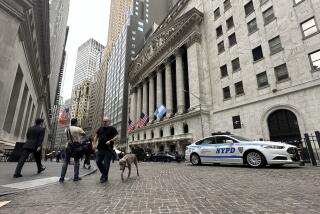Economy Beats the Odds, Grows a Vigorous 2.8%
WASHINGTON — Despite a weighty assortment of baggage, the U.S. economy cruised forward at a 2.8% growth rate in the first three months of this year, startling Wall Street and challenging expert views on the strength of the expansion, the Commerce Department reported Thursday.
The gain, following anemic 0.5% growth in the last three months of last year, came in the wake of government shutdowns, a major blizzard and a strike at General Motors. It reflected unexpectedly brisk spending by consumers and business, much of it on computers, analysts said.
The news that the gross domestic product--a measure of all the goods and services produced in the national economy--had grown more than expected came as welcome news to the White House as President Clinton maps his reelection strategy.
And it suggested to some analysts that the current economic recovery, now 5 years old, may be far more stable than had been recognized.
“This is the best of all worlds--solid growth with low inflation,” declared Edward E. Yardeni, chief economist with the Deutsche Morgan Grenfell investment firm in New York. “You’ve got to be awfully impressed with the performance of the economy, given that we threw a blizzard at it and had the government shutdowns.”
At the same time, the news frightened many investors, and stock and bond prices plunged. The Dow Jones industrial average fell nearly 77 points and the interest rate on 30-year Treasury bonds edged over 7% for the first time in nearly a year. The recent rise in interest rates is leading to higher rates on mortgages and other loans and raises the cost of borrowing for businesses--actions that eventually could have the effect of slowing down the economy.
“The market is fearful that Alan Greenspan is going to hike interest rates,” explained Sung Won Sohn, chief economist at the Norwest Corp. in Minneapolis. Greenspan is chairman of the Federal Reserve Board, which adjusts interest rates upward as a strategy for quelling inflation.
While a 2.8% growth rate normally would be viewed as moderate, analysts said that the number understates the economy’s actual strength, given the peculiar burdens that the economy was working against earlier this year. Without the GM strike, for instance, growth would have reached a more ebullient 4% rate, the government reported.
Yet Thursday’s report offered little evidence of an inflation problem. One price measure, known as the GDP Price Index, rose at just a 2.5% annual rate.
The growth report is just the latest in a recent series of statistics which suggest that the national economy is heartier than many had thought. The Commerce Department also reported Thursday that U.S. factory orders rose 1.5% in March, the first gain of the year. Separately, claims for jobless benefits slipped last week to the lowest level in more than three months, hinting at strength in the labor market.
And earlier this week, the industry-funded Conference Board said that consumer confidence had surged dramatically in April.
“This is plain and simple good news for the American economy, and more evidence that the president’s economic strategy is paying off,” declared Laura D’Andrea Tyson, a White House advisor who heads the National Economic Council.
The Clinton administration has argued that the nation’s underlying economic health is more positive than the image created by corporate layoffs and the often-discussed anxieties of workers. Officials said that Thursday’s report highlighted the important role of business investment in the current expansion, a factor that could pay off for years and also reflected a buoyant attitude on the part of consumers.
One key to the recent economic growth was a 3.5% increase in overall spending by consumers, the group that powers two-thirds of the U.S. economy. Another was business purchases of equipment, notably computers and computer-related technologies, which shot up 14.5%.
“This is a clear sign that technology is becoming a very important source of growth in the U.S. economy,” Yardeni said.
A worsening trade deficit acted to restrict the growth level for the first quarter, as did moves by business to pare inventories that had piled up last year.
Many forecasters still expect the pace of growth to ease later in the year as debt-saddled consumers ease back on purchases and housing construction slows because of higher interest-rate levels.
Nonetheless, the report left the clear impression of sturdy and persistent growth, raising fears for some investors that the Federal Reserve Board might hike interest rates in a preemptive strike against future inflation, as it has done in the past.
The agency’s policymaking Open Market Committee meets later this month, and most economists expect it to leave rates alone for the moment. But until recently, many investors had expected further rate cuts.
Increasingly, the question has become not how weak is the economy but how strong is it.
“It’s much stronger than anticipated, and the better news is yet to come,” Sohn said. “We expect the second quarter to be stronger than the first quarter.”
* HIGHER RATES: Mortgage rates surge; Dow drops nearly 77. D1, D3
More to Read
Inside the business of entertainment
The Wide Shot brings you news, analysis and insights on everything from streaming wars to production — and what it all means for the future.
You may occasionally receive promotional content from the Los Angeles Times.










